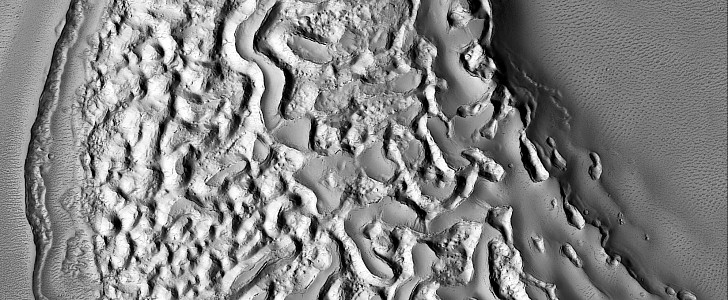Deep down, we all believe Earth is a beautiful place. A blue marble soaked with refreshing blue water, still covered in luxuriant green trees, and draped in places by vast expanses of golden sand. All these features are however just a sort of fancy clothing for the single planet we know of capable of supporting life, which if stripped of all its beauty, it’d probably be as bizarre and alien as Mars.
The neighboring planet, devoid of any elements that could cover up its naked, twisted body, proudly displays the gazillion craters, canyons, and dunes, like some ancient warrior that is proud of the many battle scars it got over the eons.
To us inquisitive humans, Mars has always been a place of bewilderment, to such an extent that we’ve sent a large amount of hardware there to take a closer look. In doing so, we’ve discovered that although far from beautiful, Mars is an inexhaustible source of strange images, showing places so weird that our brains are entranced by them, but also forced into finding some kind of meaning for them.
We’ve seen that time and time again with the many Martian orbital images we’ve discussed here on autoevolution over the past year. And the one you’re looking at now is no exception.
In reality, it shows an eroded crater deposit in the Arabia Terra region of the planet. It’s an area 5 km (3 miles) across, snapped by the HiRISE camera back in 2010 from an altitude of 285 km (177 miles). Scientists studying the image do not know for sure what caused this extreme carving of the place, but the general consensus is that the pits and troughs seen here might have been caused by “loss of ice from the surface material.”
Although not an uncommon sight on Mars, this type of feature forces our minds though into associating it with something we know and understand, and in this case, it’s like looking like a snapshot of some giant, exposed brain.
To us inquisitive humans, Mars has always been a place of bewilderment, to such an extent that we’ve sent a large amount of hardware there to take a closer look. In doing so, we’ve discovered that although far from beautiful, Mars is an inexhaustible source of strange images, showing places so weird that our brains are entranced by them, but also forced into finding some kind of meaning for them.
We’ve seen that time and time again with the many Martian orbital images we’ve discussed here on autoevolution over the past year. And the one you’re looking at now is no exception.
In reality, it shows an eroded crater deposit in the Arabia Terra region of the planet. It’s an area 5 km (3 miles) across, snapped by the HiRISE camera back in 2010 from an altitude of 285 km (177 miles). Scientists studying the image do not know for sure what caused this extreme carving of the place, but the general consensus is that the pits and troughs seen here might have been caused by “loss of ice from the surface material.”
Although not an uncommon sight on Mars, this type of feature forces our minds though into associating it with something we know and understand, and in this case, it’s like looking like a snapshot of some giant, exposed brain.






